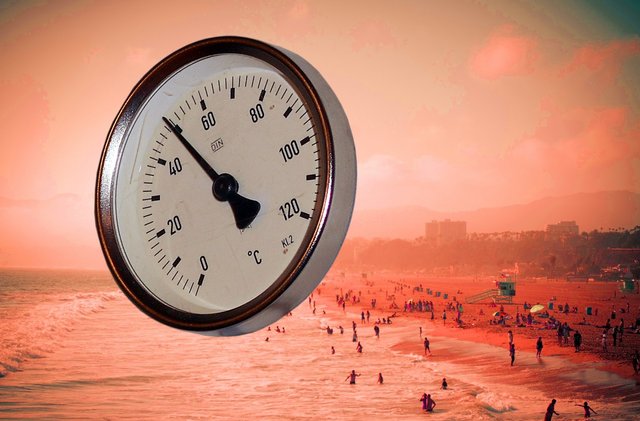What is more dangerous, the cold or the heat?
It is well known that extreme climates are very dangerous, either freezing temperatures or stifling heat, but among the extremes, exposure to cold tends to be more dangerous than heat, low temperatures cause 10 times more deaths than heat according to a report published in the journal The Lancet Planetary Health, the interesting thing about this article is that the authors also report that this trend could be reversed in the future because of climate change.

Extreme climates are dangerous. Source: Source: pxfuel images, heat and cold.
The conclusions of this article are based on a time series study of the relationship between mortality and environmental temperatures in 147 regions of 16 European countries, both in rural and urban areas for an observation period between 1998 and 2012. These associations were then used to perform simulations of possible future scenarios and to make projections of temperature-attributable mortality.
Although it is true that heat and cold do not currently have the same mortality rate, based on their projections, the authors of the article warn that if we continue with the rate of global warming and greenhouse gas emissions, the increase in heat-related deaths at the end of the century will be higher than the increase in cold-related deaths in the European region.
In the near future there will be a decrease in cold deaths due to global warming, since cold deaths are related to the increase of infectious diseases that do not appear in warm climates, something that serves as an argument for those who do not want to take more radical measures to replace the use of fossil fuels, but it is estimated that by mid-century there will be a turning point and there will be more heat-related deaths, because this also has an impact on health, the increase in hot days has an impact on cardiovascular diseases and also increases pollen and other allergenic factors typical of summers.
But the predictions depend on the scenario for the future. For the simulations carried out in the study, three possibilities were considered, an optimistic one in which the emission of greenhouse gases is reduced at great speed in accordance with the objectives set out in the Paris Agreement, with which a global temperature increase of 1.67 °C is expected, another less optimistic scenario with the actions taken and leading to an increase of 2.9 °C by the end of the century, and finally, the unfavorable scenario of continuing with the current model and continuing with the same amount of emissions, which would lead to a temperature increase of 4.5 °C, was considered.

The current rate of climate change offers an unfavorable scenario for the second half of the century. Source: pxhere.com.
In the worst-case scenario, the anomalous temperature projections show a progressively steeper increase in temperature between 2070-2099, with the increase in the fraction of deaths attributable to heat beginning to outstrip the reduction in the fraction attributable to cold in the second half of the 21st century.
However, these simulations highlight the critical importance of taking stronger action against climate change, since the fraction of deaths attributable to heat will only remain stable in the scenario of a 1.67 °C global temperature increase, while the fraction of heat-related deaths in the scenario of a 2.9 °C increase would increase rapidly by the end of the century.
Undoubtedly, the conclusions of this study expose the importance of applying more effective mitigation policies in the short term, especially in the European region, which has become vulnerable to climate change, both due to the increase in average temperatures and to the climate extremes recorded in recent years. In addition, other extreme phenomena associated with global warming, such as floods and droughts, increase the risk of deaths related to natural disasters and jeopardize food security in many regions of the planet.
Thanks for coming by to read friends, I hope you liked the information. See you next time.

Hi @emiliomoron
Certainly among the many consequences of the emission of greenhouse gases is the impact on the climate, the variation of temperatures is a serious problem that increases rapidly and the solutions do not arrive as quickly.
Excellent reading, thanks for sharing it.
Regards.
That's right my friend, this is a terrible consequence of our impact on the climate and the solutions are not as fast as the speed with which we degrade the environment. Greetings!
@emiliomoron Unfortunately everything you expose here is worrying, environmental pollution has been a factor that industries do not want to take into account even though it puts life on the planet at risk...thanks for sharing!
Hi @yossaeluz, it really is an alarming situation, unfortunately it is a sensitive issue that hits many economic interests, life is not valued above the economic.
Anything in life in the excess form will be dangerous and the same goes for temperature, very hot isn't a healthy temperature neither very cold is. Cold temperatures are for sure more deadly as our body has ways of generating heat but not enough for the very cold temperatures, but if it happened and a person who used to live in an average temperature place then moved to a cold place and start putting himself under cold temperatures regularly by using ice baths of instance would be able to bear the cold weather better as for his brown adipose cells can function better since they are a reason for generating heat and energy in our bodies.
Nice read, thanks for sharing!
Extremes are dangerous, and we are seeing how our climate is transforming, what is dangerous is the set of diseases associated with these climates rather than the temperature itself. Greetings my friend.